The choreography evolves from walking to whirling, from moves as plain as street signs to the complex body language of emotional enigmas. Village Voice 5/5/05
A PALPABLE HIT
Mark Morris Dance Group / BAM Howard Gilman Opera House, NYC / April 19-23, 2005
This year, the Mark Morris Dance Group brought no brand-new, grand-slam work to its annual season at BAM. The sole novelty was a piece that had its premiere last fall, way west, in Berkeley, California. But it’s a honey. Rock of Ages, set to the adagio movement of Schubert’s Piano Trio in E flat, is a small, quiet dance that, like meditative deep breathing, expands the consciousness until it seems to reach the deepest feelings and an ever-widening understanding of how the world works.
Its population of four, plainly dressed, enters one by one from the four 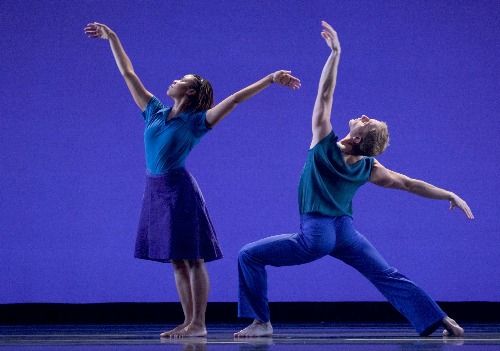
Dominating the dance are brief phrases that, after their original impulse, slow and then coalesce into sculptural poses; these, having registered, melt into the succeeding phrase. Certain gestural motifs keep repeating as if they were lodestars. In one, the dancer turns her/his back to the audience, extends one leg behind herself diagonally and stretches her arms behind her back, hands clasped. She turns her head to one side, tipping it downward as if to examine the earth, then suddenly twists it to the other side, and upward, as if scanning the sky. (I thought of 9/11. How could you not?) Elsewhere, a single dancer faces the audience dead on, legs wide, knees deeply bent, arms extended horizontally, as if measuring the space or rooting herself to mark it as significant.
The dancers seem to traverse the stage at random (though even the most casual examination of the choreography reveals that their placing and timing are exquisitely plotted). Encountering one another, they don’t appear so much to be relating as singular personalities with private agendas as simply participating in the same event or sharing, almost anonymously, a common feeling. (Again I thought of 9/11. How could you not?) Occasionally they cluster–in pairs, occasional trios, even all four together, but only very briefly, for the stream of the dance is very fluid—then quickly regroup, exit, reappear. They look into the distance a lot, occasionally at each other, in a prevailing state of self-contained contemplation. Some swift and airborne things happen, too, but they’re just accents placed by a master well aware of the pitfalls of self-indulgence.
The whole dance emanates from the music as if Schubert’s sublime trio were—on this particular playing—being rendered as a quartet. The choreography has a calm, fated feeling; everything that happens is presented as acceptable and accepted, on a plane that lies beyond the tumult of contradiction. I wanted it to go on forever; when it was over, I wanted to see it again right away.
In the engagement’s four performances, eight dancers, ranging from veterans (among them, Joe Bowie, whom followers of the troupe love like family) to a relative newbie (the heavenly Rita Donahue), rotated in the four roles—in different combinations. Morris is the last choreographer on earth to consider his dancers interchangeable. But they are replaceable, instructively so. The shifting distribution of personnel—a tactic used in other parts of the repertory as well—shows any spectator on a repeat visit how a choreographic text, while remaining stable, is significantly inflected by the performing artists essential to bringing it to life.
This one-program engagement also boasted a burnished production of Morris’s 1995 Somebody’s Coming to See Me Tonight. Set to familiar songs by Stephen Foster, it illustrates Morris’s great gift for continually shifting tone within a single work, deepening the overall effect of the choreography by playing one mood against another or, more typically and wonderfully, intertwining them to reflect the way in which real life experience sends us multiple simultaneous messages. At the time of their composition (the mid-1840s to the mid-1860’s), Foster’s songs reflected prevailing sentiments in genteel American culture. Subsequently they came to be considered over- (even nauseatingly) sentimental. Nowadays they’re hailed as examples of classic Americana. Revealing the profound shadings that bodies can lend to words, Morris constructs scenes that find innocent tenderness in love and a final (even welcome) peace in death. Abutting or coexisting with these echt-Foster evocations are ironic takes on the lyrics that infuse them with bawdy humor or irrepressible gaiety (as in the polka that’s rendered in square-dance formations with an odd man out) and an underlying sense of life’s tragic dimension. Like almost all of Morris’s choreography, the piece is immaculately structured, with patterning at once surprising and satisfying in the way Balanchine’s is. The dancers, attentive to details of gesture and feeling, make it luminous.
The program was completed by Silhouettes, a disquisition on mirror-imaging, as well as From Old Seville, a riff on the excesses and beauties of flamenco style, which is too short, and Rhymes With Silver, a glorification of its Lou Harrison score, which is far too long. Seville featured Morris, who, though growing ever more portly as he winds down his performing career, is as rhythmically acute as ever, and Lauren Grant, a tiny, swift, well-muscled blonde, who refuses to be upstaged by the boss. Silver employed just about everyone but Morris, and, if there’s a grander heterogeneous troupe of dancers around, I’d like to know where it is.
Photo: Susana Millman: Michelle Yard and Craig Biesecker in Mark Morris’s Rock of Ages
© 2005 Tobi Tobias
New York City Ballet’s Sofiane Sylve
Sofiane Sylve’s sheer physical vitality feels like an engine that energizes the entire theater, filling it with joy. Village Voice 4/19/05
Peter Boal & Company; Paige Martin and Caitlin Cook
Retiring from the stage in June, Peter Boal, longtime New York City Ballet principal and a bastion of pure classical dancing, appeared with his chamber company for perhaps its final season. . . . Paige Martin and Caitlin Cook: A program curated by pomo dance celebrity Sarah Michelson should have been more striking. Village Voice 4/19/05
DANCING DIGITALLY
Trisha Brown Dance Company / Rose Theater, Lincoln Center, NYC / April 13-16, 2005
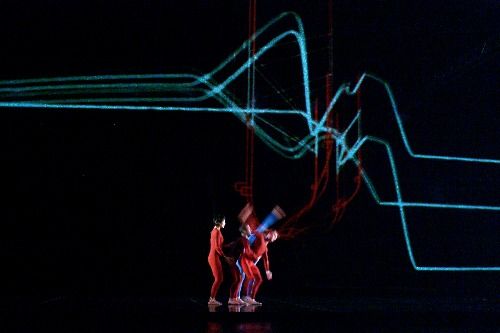
Celebrating her company’s 35th anniversary and adhering to her ongoing impulse to “make it new,” Trisha Brown devoted the second of the two programs she presented in Lincoln Center’s Great Performers series to recent work. The brand new piece that copped all the advance notice was how long does the subject linger on the edge of the volume . . . , an experiment with motion capture technology that had its premiere at Arizona State University where it was developed. (Brown co-opted the title for her piece from an overheard remark made by a techie on the project. Her maverick imagination found a wry poetry in it.)
What’s going on here? Well, to put it as simply as possible, both the ever-shifting visual imagery projected onto a scrim that veils the stage and the sound score are generated by computers receiving information from sensors attached to some of the seven dancers’ costumes (gleaming unadorned unitards in sapphire or vermillion). The images, in white sparked with bright red, consist of lines (and, subsequently, geometric shapes) that smudge, like skywriting, a few moments after they appear. Of course these animated graphics are distracting, though that’s partly because dance viewers aren’t used to scenography with a mind of its own (even if the intelligence is conspicuously artificial). The minimal score, on the other hand, is barely there.
Meanwhile, the dancers are doing the most remarkable things, many of them diverging from the vertical, the bodies leaning, lunging, jackknifing, plunging or sliding to the floor, arms, legs, and torsos rising to the challenge of tasks hardly within their original job description. Other aspects of the action derive from commonplace gesture and the groupings of crowds, this pedestrian material, absorbing in itself, unemphatically offset by some odd and beautiful lifts. Of all the Trisha Brown dances (and anti-dances) I’ve seen over the years, this one seems the most abstract, the most like Merce Cunningham’s work. The visual designs, however, bring to mind the mid-twentieth century explorations of Alwin Nikolais—all done, it should be noted, with unsophisticated equipment but quite similar results.
Occasionally the visuals get so feisty, you hardly notice the dancers, who at those moments appear small, insignificant, all but obscured, as if graffiti had been sprayed over them. Even when the images are more subdued, the scrim necessary for their projection thwarts the dancing, making it look more like something seen on TV than live performance. Tellingly, all the articles I read in advance of the New York premiere—the experiment was clearly a publicity magnet—made almost no mention of the particulars of the choreography. Elizabeth Zimmer, writing for the Village Voice, reports that the youngish techno-artists participating in the project complimented the 68-year-old Brown on having “a digital sensibility.” Has choreographic intelligence, I wonder darkly, become insufficient?
Two earlier works filled out the program. Geometry of Quiet, created in the aftermath of 9/11, is muted, intimate, infinitely tender. Its rarefied music, by Salvatore Sciarrino, played onstage by the flautist Mario Caroli, evokes a slew of natural sounds such as breathing, ocean waves invading and receding from the shore, wind in a vast tunnel, bouts of coughing, and fragments of birdsong. Jennifer Tipton’s lighting creates a perpetual dawn in which the sun seems veiled—as if by fog or clouds in the sky or smoke rising from the earth. Christophe de Menil has dressed the six dancers in the white of angels and medical personnel, and Brown herself has framed the stage in panels of rippling white cloth, giving the dancers long translucent stretches of the fabric that they pull toward the center of the space to suggest shelters or, perhaps, sacred areas.
Delicacy is the watchword of this dance. Like Agnes Martin’s paintings, it records a spectrum of subtleties. In an atmosphere of rapt attention, the dancers execute their small precise gestures, their infinitesimal shifts in weight and placement in the space. Many of the movements suggest succor—body clasping body, bodies gathering in small, tight clusters. Very occasionally, the action becomes angry, even ferocious, but these passages are so brief and their execution so fastidious, they never contradict the overall mood. At the heart of the piece lies a duet for a small man and a tall woman. Its leitmotif of discrete phrases that resolve in sculptural poses suggests that the experience of a moment may have an ongoing life in history. The fact that this duet is echoed immediately by a second couple (in which the heights are reversed) reinforces a complementary idea—that individual experience expands into communal experience. At the finish of the piece, the pale light finally fades altogether, much more swiftly—as in much of human existence—than one would have expected.
I have a predilection for art in this exquisite vein, and I liked Geometry of Quiet very much. A colleague sitting next to me found it exasperating.
Present Tense, made in 2003 but new to New York, offers a good example of Brown’s divine fluidity—the aspect of her choreography that streams directly from her own body, her unique physical temperament. Set to selections from John Cage’s Sonatas and Interludes for Prepared Piano, it opens with a long male solo (handsomely danced by Neal Beasley) full of squiggles and loping. The dance then unfurls into a septet that, using a typical Brown tactic, moves laterally in and out of view, much of the action concentrated on the peripheries of the space. The choreography makes canny observations on how people combine or bond, especially when they’re supporting each other’s bodies, either in pairs or larger groups. Eventually the participants help each other soar aloft, outstretched limbs slicing the air.
I thought the proceedings were intermittently funny, but the audience didn’t respond along these lines, at least not overtly, remaining reverently still, as if awed by the evening’s air of a visit to the cutting edge. And yet the dance was, at the very least, playful, the brightly clad bodies repeatedly trying out moves or spatial relationships, then shaking their heads no and nodding them yes, like little dolls set in motion by a playful inventor in a toy landscape. Present Tense actually has a landscape—a backdrop by Elizabeth Murray depicting a Keith Haring-like figure neatly sandwiched between the treetops of a forest and low-hanging dark clouds in what I assume is a faux-naif comment on the human condition.
Photo: Tim Trumble: Members of the Trisha Brown Dance Company in Brown’s how long does the subject linger on the edge of the volume . . .
© 2005 Tobi Tobias
KEEPING GRAHAM GOING
Martha Graham Dance Company / City Center, NYC / April 6-17, 2005
The trouble with Martha Graham is that, alive or dead, the lady can’t be relied on. She is, indisputably, one of the key choreographers in the history of Western dance. The Martha Graham Dance Company’s current City Center season, restricting itself almost entirely to carefully shaped productions of masterpieces like Primitive Mysteries, Appalachian Spring, and Errand Into the Maze, proves this point anew. However, more often than not, the work of the last third of Graham’s long career was inflated and vague, almost to the point of self-parody, and thus hardly worth conserving in the active repertory. So the viable Graham canon is limited and, though the power of the company rests with the great old works, neither the troupe’s audiences nor its dancers will accept having their experience confined solely to these pieces.
For this reason, the current directors, Terese Capucilli and Christine Dakin, commissioned their first new work for the group—from Martha Clarke. Emerging from Pilobolus in the seventies, Clarke choreographed and directed for major ballet and opera companies and created independent productions that led to her copping one of those MacArthur Awards that lets folks think of you as a genius. The Graham assignment resulted in Sueño (Dream), inspired by the Goya etchings collected as Los Caprichos (1799) and Los Desastres de la Guerra (1810-1814)—mordant depictions of the evils rampant in Spanish society and, by implication, in humanity at large.
Clarke has a fervid imagination (a quality Graham shared without letting it overwhelm her), and an insatiable appetite for the grotesque. Sueño is extravagantly picturesque. Its eleven haunted figures inhabit a very dark stage, where set and costumes are restricted to a palette ranging from black, through ash gray and silver, to a spectral white. The dancers’ wildly moving shadows create menacing silhouettes on huge mottled panels placed at rakish angles, the constant unsettling fluctuation of the forms augmented by the women’s loose-hanging hair and ragged skirts. In the same vein, the frenzied movement is intermittently accompanied by laughing, screaming, raucous shouting, sinister whispering, and, at one juncture, the antiphonal hand-clapping of Spanish dance.
Image upon image whirls before our eyes, depicting violence, sexual depravity, grief, despair, decay—and the near manic pleasure the participants take in their own dissolution. The populace scuttles around in the gloom, doing forbidden things or having horrific things done to them, spying gleefully on one another’s nasty diversions.
All this, performed with vigor and abandon, is stunning for a few minutes. It looks like the introductory passage to a heady, menacing film—after which you’d, quite naturally, expect incident, character, and finally some semblance of story to emerge from the atmospheric vortex. In Sueño this never happens. Although a few specific incidents stand out in the general mêlée—the rape of a redhead by three men, a vicious confrontation between a matador and his human bull/slave—they are very brief, a matter of seconds. For the most part, the piece goes on for over twenty hectic minutes without rendering anything more than a Carnival in Hell ambiance. Towards the end, as if Clarke had suddenly realized she’d produced nothing of conventional dramatic substance, one man mounts a precarious towering panel, his neck wrapped in a hangman’s noose. He harangues the small crowd of death-infatuated revelers below, then leaps from his perch to his “death” (flying effects by Antigravity). Clarke resurrects him after a bit, and he laughs hysterically, his hands clutching a pair of clanging bells.
Franco Piersanti’s score, Riccardo Hernandez’s set, Donna Zakowska’s costumes, and Christopher Akerlind’s lighting all contribute mightily to Clarke’s intended effect. The effect, however, though initially ravishing, does not constitute a dance. It has little of the quality of Graham’s landmark works—no governing passion, for one thing; no redemption, for another—and, for that matter, little relation to Goya, who never treated the morbid as if it were intoxicating décor.
The real choreographic event of the season turned out to be the revival of 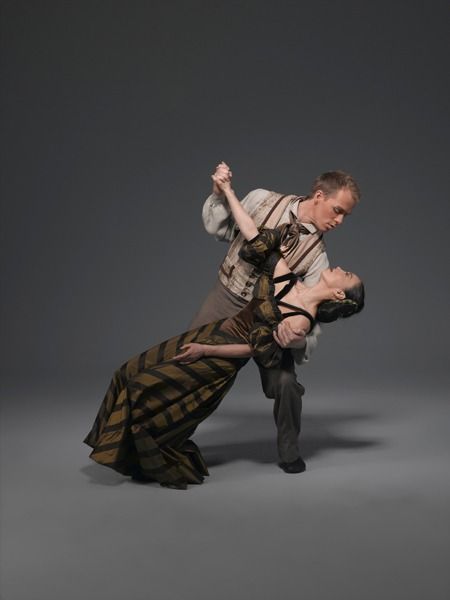 Graham’s 1943 Deaths and Entrances, an evocation of the turbulent lives of the Brontë sisters, its emotional climate as roiling as that of Emily’s Wuthering Heights. The piece centers on one of the sisters (originally danced by Graham herself, and whom we can take to be Emily, the one cursed by genius, Charlotte and Anne being merely immensely gifted). This figure works out her terrible conflicts and achieves some sort of ecstatic resolution in a matrix peopled by her sisters, incarnations of their three child selves, rival suitors evocatively called The Dark Beloved and The Poetic Beloved, a pair of auxiliary gentlemen, and an enigmatic collection of props. A transparent goblet, an enormous seashell (the kind that lets you hear the ocean’s implacable waves in the cleft formed by its swollen pink labial folds), and a pair of phallus-like chess pieces are manipulated by the dancers as if they, at least, knew exactly what the objects signified.
Graham’s 1943 Deaths and Entrances, an evocation of the turbulent lives of the Brontë sisters, its emotional climate as roiling as that of Emily’s Wuthering Heights. The piece centers on one of the sisters (originally danced by Graham herself, and whom we can take to be Emily, the one cursed by genius, Charlotte and Anne being merely immensely gifted). This figure works out her terrible conflicts and achieves some sort of ecstatic resolution in a matrix peopled by her sisters, incarnations of their three child selves, rival suitors evocatively called The Dark Beloved and The Poetic Beloved, a pair of auxiliary gentlemen, and an enigmatic collection of props. A transparent goblet, an enormous seashell (the kind that lets you hear the ocean’s implacable waves in the cleft formed by its swollen pink labial folds), and a pair of phallus-like chess pieces are manipulated by the dancers as if they, at least, knew exactly what the objects signified.
The dance has been re-costumed by Oscar de la Renta, and the gowns for the women are ravishing. They provide just enough period reference to make them probable and a huge dose of svelte glamour that connects them to the present day. Their palette—cinnamon, red violet, and black-striped bronze—gives off a sullen glow and makes an erotic object of the dancers’ skin, astutely bared at the neckline and shoulders. Referencing mid-nineteenth century dress, the construction is thick and elaborate at the pelvis, while the skirts trail behind just a little, surging and swirling as the women’s rapacious extensions and tormented swiveling animate them. (The Three Remembered Children’s schoolgirlish dresses are a little overwrought—Lolita-ish, if you take my meaning—but then adults cast as children almost always appear faintly obscene.)
Graham scorns plot for this piece and refuses even to make her characters and their feelings specific enough to be labeled. Yet she manages to sweep away the viewer susceptible to her methods and concerns. I, for one, having read my share of Brontë novels, could easily imagine the three sisters cooped up in the ill-fated family’s home near the wild moors, writing away and dying of TB, entertaining visions of romance and passion as the grave beckoned to them.
The movement Graham invented for the piece is particularly disturbed (and disquieting). The super-energized disjunctive phrases, with single gestures set in relief, look as if desire and anguish, storming the barricades of repression, had finally unleashed their lethal force. Graham convinces you here, as she does in all her top-notch tragic works, that the only life worth living—even if it invites chaos and leads to annihilation—is an existence at emotional extremes.
Miki Orihara, who is having a splendid season—in Appalachian Spring, her Bride brings tears to your eyes—is terrific as the Emily figure. She depicts longing and loathing ferociously, yet remains infinitely delicate. In one solo passage, having lost both the Dark and the Poetic Beloved, she appears to be a fragile, priceless piece of porcelain that suddenly shatters. Then, in the next moment, as if through an immense effort of will, she composes herself, absorbs her tragedy, internalizes it, and becomes, body as well as face, a mask—invulnerable because she is unreadable.
Orihara’s beautiful performances are topped only by those of Fang-Yi Sheu, the most gifted interpreter of Graham to appear in decades. Sheu shares with Orihara the ability to create a character through an intimate involvement with the persona and the situation and, at the same time, to portray that figure objectively. No mean feat, this; it’s like using Method and Classical acting techniques simultaneously. Her dancing per se offers dozens of things to admire. Her small willowy body seems infinitely fine-boned and malleable, yet her strength is steely and her projection intense. Details? In Errand Into the Maze, you watch, fascinated, as she enters the metaphorical labyrinth, her feet, like some feral creature’s, pacing out the path traced by an undulating rope laid along the floor. The body seems to float, almost formless, above these precise, stalking feet, as if in a trance. In Cave of the Heart, she gives her Medea hands that work like prehensile claws and a torso and pelvis overtaken—spontaneously, it would seem—by spasms that spell out jealous rage. But it’s the overall effect that’s most astonishing. Sheu makes you feel that there’s nothing learned or calculated about what she’s doing on stage. It’s as if the dance is inhabiting her, making her its vehicle—as if she had relinquished herself to Graham’s imagination. If you can get yourself into the neighborhood of the City Center, go see her. Right now. This sort of dancing is rare, and it doesn’t last forever.
Photo: John Deane: Miki Orihara and Tadej Brdnik in Martha Graham’s Deaths and Entrances
© 2005 Tobi Tobias
ARTSJOURNAL
ARTS & LETTERS DAILY
BALLET.CO
BALLERINA GALLERY
THE DANCE INSIDER
DANCEVIEW TIMES
FOOTNOTES
GREAT DANCE WEBLOG
THE WINGER
The RÉUNION DES MUSÉES NATIONAUX (The National Museum Association’s Photographic Agency) offers a photographic catalogue of some 200,00 holdings of French museums. It can be searched by artist, country, period, subject, and so on. You can make a personal album of your favorites on the site. New York’s Metropolitan Museum of Art and D.C.’s National Gallery have similar services, but the French one is the most ambitious and extensive. Text in English as well as French.
AddALL is an ultimate umbrella for finding used and out of print books online. It doesn’t have the atmosphere of Foyle’s, Powell’s, or even the Strand, but it will give you every opportunity to need yet another bookcase.
PROJECT GUTENBERG More books.No bookcase required.Over 6000 free electronic texts.
CALLIGRAPHY LESSONS ONLINE Learn the italic hand and make yourself legible. Don’t miss the animation.
Color charts of HERBIN INKS. If you have to ask, you’ll never know.
THE NEW YORK TIMES Because it’s there.
https://www.artsjournal.com/tobias/2005/04/artsjournal_arts_letters_daily.html
Wonder Women
This article originally appeared in Tutu Revue.
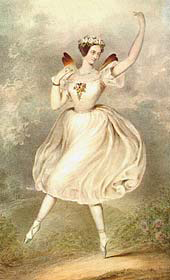
Marie Taglioni as the Sylphide
There’s a subdivision of feminist thinking that condemns the beloved storybook ballets of the nineteenth century for their ostensible political incorrectness. All those sylphs and Wilis, it maintains, all those maidens suspended in states of enchantment represent women as frail, vulnerable creatures, deprived of power over their own destinies, the victims–often in the name of love–of dominant men.
I think it’s absurd to apply sociological convictions and agendas to aesthetic creations–particularly when it comes to the sociology of one era and the art of another. It’s even more wrong-headed, surely, to argue the case from inaccurate observation. Examine, as I’m about to do here, the heroines and their sister protagonists (foils, alter-egos, even villains) of a half-dozen evergreen ballets from the Romantic and Classical eras and you’d be hard put to find a spineless female among them.
Consider first La Sylphide, which set the tone of Romantic ballet. Though she appears exquisitely fragile and defenseless, a creature of gossamer and mist, the Sylphide is one dangerous lady. She’s as amoral as the workings of nature; her mercurial temperament–tears one moment, ecstatic joy the next–is like changing weather. She loves James–indeed, as she relates in a mime passage now regrettably omitted in some productions, she has been watching him since he was a little boy, stalked him when, as a young man, he hunted in the forest.
Free from a sense of responsibility for her actions, impervious to guilt based on an awareness of others’ feelings, the Sylphide reasons: If I desire him, he should be mine. This is the simple narcissistic logic of a child, untamed by civilization. The Sylphide’s ingenuous offerings to James–the wild strawberries, the bird’s nest with its delicate cargo, the spring water she cups in her hands, rushing with it on tiptoe to her beloved–are as impulsive and impractical as a kindergartner’s and equally willful.
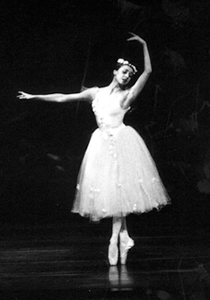
Nina Ananiashvili as the Sylphide
We domesticate our children to keep them from ravaging the social fabric. The Sylphide is a creature who has escaped this process; she runs beautiful, wild, and free–destroying everything in her path and herself as well. One may pity her in her poignant death throes. Yet she has contributed to her own undoing, coveting the secretly poisoned scarf with which James pinions her as if it were a tantalizing toy that was her due–just as she coveted James. Surely everyone in the ballet, to say nothing of its audience, would agree that this figure is hardly weak or passive, but rather a force to contend with.
The role of the other important woman in La Sylphide–the witch, Madge–is often played by a man, and to great effect (think Erik Bruhn, think Niels Bjørn Larsen). But the character is female, and an icon of terrible strength. Clad in dirty rags, warming herself at other folks’ fires, earning her tot of whiskey by telling fortunes, Madge masquerades as one of the powerless. When she first infiltrates James’s house, she appears to be a pitiable old woman–crippled, poverty-stricken, without a hearth to call her own.
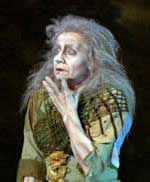
Kirsten Simone as Madge
Courtesy Royal Danish Ballet
© Martin Mydtskov Rønne
Deprived as she is of life’s material necessities as well as any kind of social standing, she seems to be harmless. At best she’s an object of her community’s indulgence and charity. Her thoroughgoing impotence turns out to be a canny disguise. Taking her revenge for a casual insult, she ruins both James and the Sylph–in other words, the poet and his vision.
Effy, James’s betrothed, deserves consideration here too, though she’s only a secondary character in the ballet. She displays a kind of staying power common to women: She accepts life’s blows and makes do. At first, when James, choosing to follow his dream, jilts her (and the snug domestic milieu she represents), Effy behaves as if felled by tragedy. Act I of the ballet closes on a tableau of her utter despair.
Midway through Act II, however, she regains her equilibrium and turns sensible before our very eyes. Recognizing the impossibility of recovering her true love, she thinks things over and, with sweet resignation, agrees to marry her other suitor, Gurn. He’s a nice ordinary fellow, undistracted by illusions, who will provide her with a settled life warmed by his devotion, children (humankind’s instinctive bid for immortality), and the small, quiet joys of the commonplace.
In no way can he replace James in Effy’s imagination; he’s a character dancer, after all, not a danseur noble. Gurn represents mere reality, and Effy has the good sense to accept this as the best choice remaining to her. It’s not an ignoble one. It allies her with legions of women whose unsung heroism consists of a steadfast consent to what life has offered them.
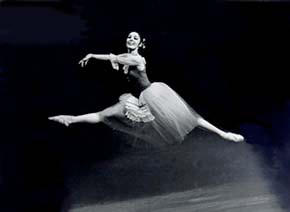
Galina Mezentseva as Giselle
Now think of Giselle. Granted, its heroine at first epitomizes the kind of innocence that so often guarantees its own undoing. Giselle allows herself to be taken in–seduced, if you will–by Albrecht, one of those aristocrats who amuses himself by going slumming amidst the local peasantry. Depending upon the reading a particular production and its leading dancers give to the libretto, Albrecht may be truly in love with the unworldly girl. Still there’s no denying that Giselle is the victim of his deceit and that he fickly betrays her when confronted by his fiancée, Bathilde, and the full force of the court that is his “proper” social sphere.
Even in Act I, however, Giselle demonstrates considerable self-assertion. She steadfastly rejects the persistent courtship of Hilarion who, within their social circle, is the logical match for her. And she subverts her mother’s orders not to tax her weak heart by dancing, which to her is not merely joy but necessity. In other words, she persists in following the dictates of her own needs and desires despite the pressures of the confined world in which she dwells.
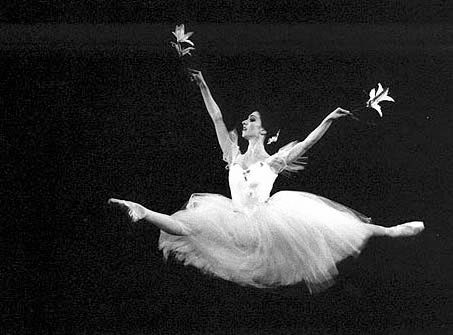
Joanna Berman as Giselle
In Act II, Giselle becomes strength incarnate, emerging from beyond the grave, a wraith not yet leached of human feeling, to rescue her unfaithful lover from the death sentence of the avenging Wilis. Giselle’s victory here is a triumph of the pure spirit impelled by sheer volition.
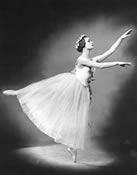
Alla Sizova as Myrtha
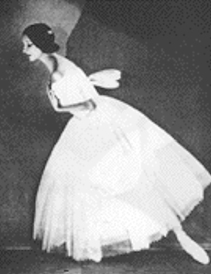
Olga Spessivtseva
as Giselle
The power of Myrtha, the implacable queen of the Wilis, is unambiguously superhuman, so perhaps this figure doesn’t earn a place in the pantheon of feminist role models. Still, the character can be understood as a metaphor for women who go into battle for a cause, impelled by rage (just or unjust) and nearly impervious to defeat because their entire being is focused on their single-minded conviction.
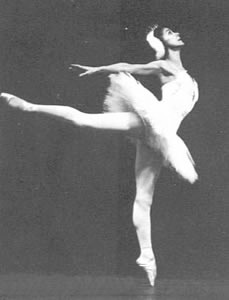
Margot Fonteyn as Odette
In Swan Lake, the White Swan and the Black Swan, Odette and Odile, respectively embody the power of sublime good and monstrous evil. Odette, despite her lamentable situation–she’s a princess doomed to captivity, deprived even of her human form–is not entirely defeated. First she protects her sister prisoners against the hunters who see the magnificent white birds as their legitimate prey. Then she pleads her case with their leader, Prince Siegfried, so eloquently that his sympathy escalates into a pledge of love and commitment. Once the hope he holds out is sabotaged, she has the courage to end her own life.
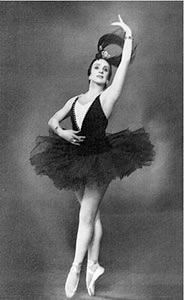
Natalia Dudinskaya as Odile
Odile, scion of the evil sorcerer von Rothbart, is clearly her father’s daughter, reveling in her ability to annihilate any manifestation of purity, beauty, and trust. She’s even more potent a threat than von Rothbart, since she adds erotic power to her dad’s arsenal. It’s not that she wants Siegfried; she wants Siegfried destroyed, along with the very essence of Siegfried’s bond to Odette.
Once psychology was widely accepted as a science, ballerinas performing the dual role of Odette-Odile began to comment that they saw the two personalities as different aspects of a single character. The notion has proved useful. Legend, as well as much literature and film of the past, often made its effect by contrasting monolithic types–the good girl versus the bad girl. The idea that every more or less good girl contains a healthy portion of bad girl impulses (and vice versa) allows for a welcome richness of character and behavior in female heroes and villains. It helps today’s ballet-goers, who may be leery of old-fashioned fantasy, identify with the imaginary figures who populate yesteryear’s landmark works. It gives us a way in.
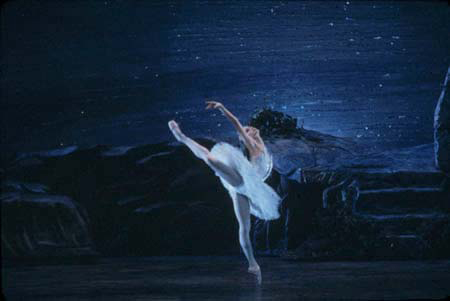
Irina Dvorovenko as Odette Courtesy American Ballet Theatre © MIRA
Swanilda, the heroine of Coppélia (Coppélia, you’ll recall, is the mechanical doll), is memorable first for her delicious temperament. She’s effervescent, the possessor of a joie de vivre so ebullient, it spreads itself over the stage, making the whole ballet radiant with happiness. There may be no more powerful gift than this.
Though this young woman’s a darling, that doesn’t keep her from being feisty. She’s as self-assertive as they come, quick to berate her boyfriend when he gets out of line, bowing and blowing kisses to the (almost) living doll in Dr. Coppélius’s window, falling, as so many hapless fellows do, for an inanimate pretty face. She even administers a quick scolding when her Franz catches a butterfly and impales it with a pin to serve as his boutonnière. (Perhaps she’s identifying with the butterfly and refusing to be anyone’s trophy.)
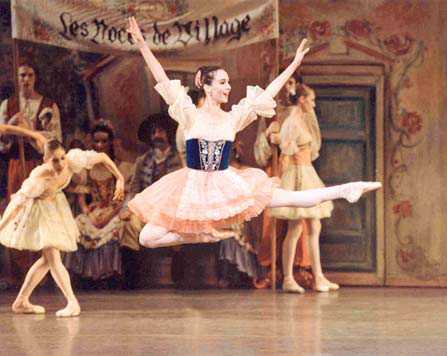
Jenifer Ringer as Swanilda Courtesy New York City Ballet © Paul Kolnick
The boyfriend, let it be noted, is unworthy of her. Oh, he’s charming, this Franz, but hopelessly doltish, and fickle besides. It takes a Swanilda, both courageous and clever, to save him from himself and claim him as her own. She braves Dr. Coppélius’s lair–the menacing laboratory of a half-crazed old man who dabbles in the dark mysteries of human life. She’s impelled by curiosity, a trait typical of an intellectually daring female. Once inside, having pluckily investigated the situation, she saves her boyfriend from having some vital part–heart? soul?–removed by the obsessed inventor who fantasizes transplanting the human anima into his otherwise perfect doll.
Like many a self-realized woman, Swanilda is not always likeable. She’s undeniably cruel to Dr. Coppélius–pretending to be his doll come to life, then mocking him as she exposes her ruse and his pathetic belief in (and love for) his creation. But her actions are necessary to the theme of the ballet, which celebrates the triumph of real human existence, with all its peculiarities and flaws, over the mechanical imitation of it, no matter how ingenious. And, once she has Franz safely in wedlock, Swanilda apologizes to the old man with the easy grace of those whom destiny has favored.
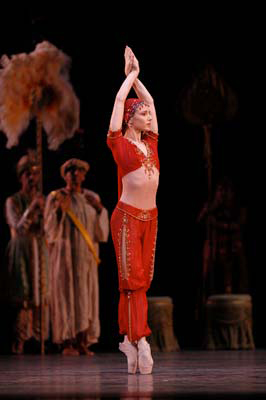
Alina Cojocaru as Nikiya
Courtesy American Ballet Theatre
© Marty Sohl
The Hindu-land melodrama La Bayadère also refutes the feminists’ complaints. It gives us the formidable Gamzatti–gorgeous, well-heeled, and well connected–who ruthlessly goes after what she feels is hers by rights (the hero) and gets it, though she doesn’t get to keep it. Admittedly, her opposite number, Nikiya, the ballet’s soulful, disenfranchised heroine, is thrice-victimized: by her rival, Gamzatti; by her lover, more resolute in war and tiger hunting than in his affections; and by the lust-corrupted priest in whose temple she serves as a dancing slave. It’s true, too, that in the Kingdom of the Shades scene, which is undeniably the heart of the ballet, Nikiya proves to be even lovelier–more touching, more desirable–in death than in life.
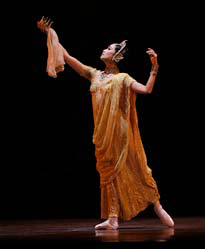
Stella Abrera as Gamzatti
Courtesy American Ballet Theatre
© Marty Sohl
Yet her very plight gives her enormous power. It moves the gods, provoking them to cause the most spectacular architectural catastrophe in classical dance, the destruction of the resplendent temple that buries every last member of the ballet’s sizable cast. The event also rewards Nikiya with a radiant apotheosis in which she and her beloved join hands in a realm of eternal bliss. Politically correct thinking, already stirred up by the slave-of-dance theme, will dub this afterlife payback equivocal. So be it. In its time and in its context of make-believe, it was satisfactory.
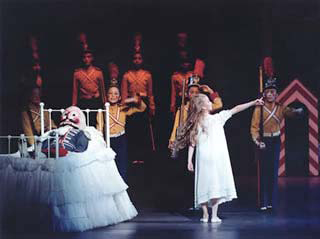
Student of the School of American Ballet as Marie
Courtesy New York City Ballet
© Paul Kolnick
If feminist polemicists are not convinced by these examples of ballet’s nineteenth-century heroines holding their own and then some, they might simply look to little Marie in The Nutcracker. Yes, she’s fearful and given to fainting when her space is invaded by rodents, one of them a royal menace with seven heads. Yes, she cedes the sword-to-sword combat with the enemy to her Nutcracker Prince. After all, she’s a typical well-brought-up child of the Victorian bourgeoisie, who knows the roles assigned to boys and girls, tomorrow’s men and women. But when the battle is going against her rescuer and cavalier, remember, it is she who has the canniness and fine aim to hurl her slipper at the enemy, distract his attention with her sure, sharp hit, and thus assure his downfall. When the child Prince recounts the story to the Sugar Plum Fairy and her court in the Land of Sweets, he gives Marie full credit for her prowess. And so should we.
© 2007 Tobi Tobias
Beth Soll & Company; Aspen Santa Fe Ballet
Soll herself is unforgettable–as alert, quick, clear, and delicate as a lark. . . . Aspen Santa Fe Ballet appeals with easily accessible choreography, forcefully executed by dancers who are as bright and attractive as the imaginary people in ads selling you vacations. Village Voice 4/4/05
Taglioni’s Shoe: Memory & Memorabilia
I was standing before a glass case — in a museum or library dedicated to theater memorabilia, I think. Or perhaps an exhibition space in an opera house. Where? New York? London? Paris? Can’t recall. When? No idea. Perhaps decades ago. All I remember —



